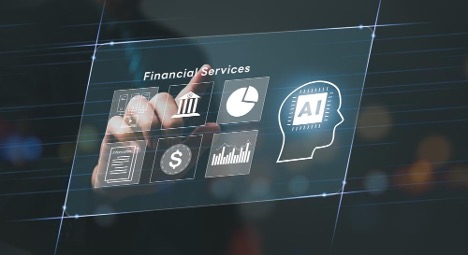
Source: Shutterstock
Abstract
Generative AI is not a future idea. It's already changing how finance works. From fraud detection and credit scoring to compliance, trading, and customer service, AI is helping financial institutions move faster, make smarter decisions, and serve more people. This article breaks down the key areas where generative AI is making an impact, what it replaces, and what it improves. It's a practical guide to where the industry is heading and why it matters now.
No, AI won’t replace your financial analyst.
But it might write their reports, approve their loans, and detect fraud faster than any compliance team can react.
What’s changing isn’t the job titles. It’s the pace, the precision, and the entire approach. From trading bots that respond to market shifts in real time, to AI assistants giving everyday users investment advice at midnight, generative AI is already working behind the scenes at banks, fintech startups, and credit platforms.
Here, I’ll break down where AI is quietly transforming finance—fraud detection, underwriting, trading, customer service, compliance, and even blockchain and what it means for how we build and use financial systems today.
1. Smarter Fraud Detection & Risk Management
Traditional fraud systems follow fixed rules, but fraudsters move faster than that. Generative AI changes the approach by learning what normal looks like for each person and spotting unusual behavior in real time.
In 2023, Mastercard’s Decision Intelligence system helped banks safely approve around 143 billion transactions a year. Their upgraded system, Decision Intelligence Pro, now uses generative AI to scan over a trillion data points in less than 50 milliseconds.
Early results show a 20% average boost in fraud detection, and up to 300% in some cases. It also cuts false positives by more than 85%, meaning fewer legit purchases get blocked by mistake.
This isn’t just faster. It’s smarter, and it’s already in action.
2. AI in Trading & Market Predictions

Source: Shutterstock
Financial markets move fast. Generative AI is helping firms stay ahead, not just by reacting, but by anticipating.
These systems pull in a wide range of data: past market behavior, current events, sentiment from financial news, even geopolitical signals. They don’t just spit out a chart. They generate possible futures. That’s especially helpful for testing trading strategies under different conditions.
High-frequency trading firms already use AI to make trades in microseconds. Portfolio managers use it to rebalance assets in response to real-time shifts. These tools aren’t replacing humans, they’re doing the number-crunching so analysts can focus on strategy.
Even retail investors are starting to benefit. Some fintech platforms now offer AI-generated investment scenarios, market commentary, or even custom rebalancing options based on the user’s goals. It’s not just about faster execution. It’s about more responsive, personalized decisions.
3. Personalized Banking (Without the Wait)
Banking used to mean waiting on hold or visiting a branch. Now? AI handles most of it.
Today’s chatbots do more than answer balance questions. They help with loan applications, budgeting tips, and even investment suggestions. Tools like Erica from Bank of America and Eno from Capital One are already helping millions of users 24/7.
What makes these tools useful isn’t just their availability. It’s that they’re personalized. Generative AI uses what it knows about your behavior and goals to give tailored advice. It might suggest adjusting your savings based on spending trends, or walk you through your credit report with clear explanations.
Back when I built messaging systems with predictive AI, the goal was to make conversations feel smoother and more natural. That same thinking is now being applied to money and it’s working.
We’re also seeing AI used to simulate financial outcomes. Want to know how much you’d save by refinancing your mortgage? Or how does your retirement plan hold up under different market conditions? AI can run those calculations and show you several possible futures, without needing a human advisor to step in.
4. Compliance Without the Headaches
Finance is one of the most heavily regulated industries out there. Compliance matters, but it’s often slow, expensive, and repetitive.
Generative AI helps by analyzing regulatory documents and comparing them to your processes, data, and transactions. It can flag potential compliance gaps, draft reports, and even catch signs of money laundering before a human would notice.
For instance, AI can now support Know Your Customer (KYC) and Anti-Money Laundering (AML) efforts by checking customer identities against global databases in real time. That kind of speed keeps institutions ahead of regulators and avoids costly mistakes.
Some platforms are even using AI to automatically track changes in regulations and adjust their policies accordingly. Instead of waiting for a quarterly review cycle, updates happen in near real time. This reduces risk, improves accuracy, and frees up legal and compliance teams to focus on tougher problems.
5. Better Credit Decisions
Not everyone has a long credit history. And traditional credit scoring doesn’t always tell the full story.
Generative AI helps lenders get a more accurate picture by including alternative data—like rent payments, subscription patterns, and even job stability. This helps people with thin or no credit history get fair consideration.
Companies like Upstart are already doing this. Their AI models factor in education, income trends, and employment status—approving more loans with fewer defaults.
According to a study, Upstart’s model approved 27% more applicants than traditional scoring systems and offered 16% lower average APRs for those approved. This shows that AI doesn’t just speed things up—it can also make lending more inclusive and cost-effective.
Some credit unions and digital lenders are beginning to experiment with their own AI-based scoring models, particularly in emerging markets where formal credit systems are limited. With better access to alternative data, financial inclusion becomes more than a slogan—it becomes possible at scale.
6. Financial Reports, Built by AI

Source: Shutterstock
Let’s be honest—financial reports can be a pain to put together. They’re necessary, but they take hours to compile and analyze.
Generative AI changes that. These tools can automatically create earnings summaries, forecast revenue, and flag unusual spending. They work with both structured data (like spreadsheets) and unstructured content (like earnings call transcripts).
Bloomberg’s BloombergGPT, released in 2023, was trained on 50 billion parameters and outperformed general-purpose models on financial tasks like sentiment analysis and news classification. It’s being used to generate reports, track market narratives, and support financial research at scale.
Finance teams in large organizations now use similar tools to produce rolling forecasts or daily cash flow updates without starting from scratch each time. It’s more than just saving time, it’s about making better decisions faster.
7. AI Meets Blockchain & Smart Contracts
Blockchain is getting more attention, and with it, smart contracts—code-based agreements that self-execute when conditions are met.
Generative AI helps by testing these contracts before they go live. It simulates different scenarios, checks for bugs or loopholes, and makes sure everything runs smoothly.
AI can also monitor activity on the blockchain to detect suspicious behavior. Whether it’s a pattern of wash trading or unusual movement between wallets, these tools help protect platforms and users alike.
We’re also seeing AI used in decentralized finance (DeFi) protocols to adjust lending rates based on liquidity or market volatility. This kind of dynamic, data-driven decision-making is becoming the norm.
Quick Look: What’s Changing and Why It Matters
We’ve covered a lot—fraud prevention, smarter lending, market forecasting, and more. To pull it all together, here’s a quick comparison of how things were done traditionally, what generative AI changes, and why those changes matter. If you're skimming or need a recap, this table brings it all into focus:
How Generative AI Is Changing Financial Operations
|
Use Case |
Traditional Method |
With Generative AI |
Impact / Benefit |
|
Fraud Detection |
Rule-based systems with static thresholds |
Real-time anomaly detection using behavioral patterns |
Faster identification, fewer false positives |
|
Credit Scoring & Lending |
Based primarily on credit history and FICO scores |
Alternative data analysis (employment, rent, spending patterns) |
More inclusive lending, more accurate risk profiling |
|
Market Predictions & Trading |
Historical trend analysis + manual strategies |
AI-generated simulations using multi-source data (news, sentiment, macroeconomics) |
Faster reaction to market signals, smarter execution |
|
Customer Service |
Call centers, FAQs, human advisors |
AI-powered chatbots providing personalized financial advice 24/7 |
Better experience, lower service costs |
|
Compliance & Reporting |
Manual audits, quarterly policy updates |
Automated regulatory tracking and report generation |
Reduced errors, faster compliance, less time on paperwork |
|
Financial Insights & Forecasts |
Manual report creation, spreadsheet modeling |
Language models generating summaries, earnings recaps, forecasts |
Real-time insights, enhanced decision support |
|
Smart Contracts |
Static contract code deployed manually |
AI-assisted simulations for testing, real-time behavior monitoring |
Fewer bugs, more secure DeFi environments |
Right now, AI is doing real work across finance. It’s not just helping—it’s reshaping how teams solve problems and make decisions. As Microsoft CEO Satya Nadella put it at the World Economic Forum:
“A golden age of AI is underway and will redefine work as we know it.”
That shift is already happening in banking, investing, compliance, and reporting, and it’s only just getting started.
What Comes Next?
Generative AI is already embedded in financial systems. It’s helping teams move faster, serve customers better, and reduce manual work across the board.
But here’s the thing: AI still needs thoughtful planning. Models must be trained on the right data, reviewed for fairness, and designed to be understandable, not just accurate. That’s not a limitation. It’s a reminder that behind every useful tool is a team that built it with care.
In my own work, whether building security architecture or mentoring engineers, I’ve seen that when automation and human insight work together, the results are always stronger.
The future of finance isn’t about replacing people. It’s about giving them tools that remove the busywork and surface better answers. And right now, generative AI is one of the best tools we’ve got.
References
- Mastercard (2024). Mastercard supercharges consumer protection with generative AI. Mastercard Newsroom, February 2024.
https://www.mastercard.com/news/press/2024/february/mastercard-supercharges-consumer-protection-with-gen-ai/ - Banking Dive (2019). Upstart’s CFPB-approved test shows alternative credit data expands access. Banking Dive. https://www.bankingdive.com/news/upstart-CFPB-alternative-credit-data-test/560426/
- Levin, D. (2023). BloombergGPT: A new era in real-time financial AI. Doug Levin on AI, Substack.
https://douglevin.substack.com/p/bloomberggpt-a-new-era-in-real-time - World Economic Forum (2023). Satya Nadella says AI golden age is here – and it’s good for humanity. World Economic Forum.
https://www.weforum.org/press/2023/01/satya-nadella-says-ai-golden-age-is-here-and-it-s-good-for-humanity/
About the Author
Suresh Duraisamy is a Senior Software Development Engineer at Microsoft. He has nearly 20 years of experience designing secure, scalable systems across finance, AI, and enterprise software. His work focuses on building tools that solve real problems and make complex systems easier to use and understand.







